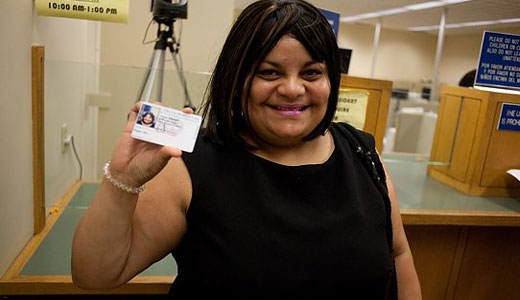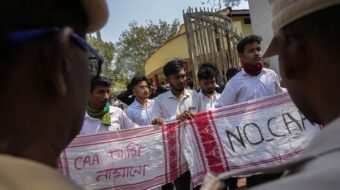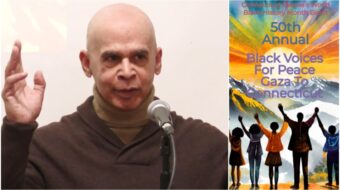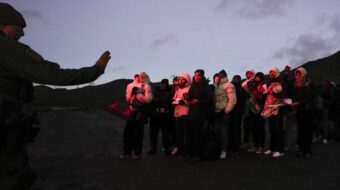
NEW HAVEN, Conn. — Speaking at a forum celebrating the fifth anniversary of the New Haven Elm City Resident Card, national immigrant rights activist Frank Sharry of America’s Voice credited the movement which achieved the card as a kickoff for many more partial victories that have followed in the wake of much needed comprehensive reform.
“This is legislation from below,” he said speaking at the Public Library during the “My City. My Card.” event. New Haven was the first city in the nation to issue an ID to all residents regardless of immigration status.
Hafid Dumet, a leader of the DREAMers movement, said the Elm City Resident Card helped inspire him and others to step forward on behalf of their own needs for affordable college education. They were successful in winning a state law this year allowing Connecticut high school graduates without documents to attend state colleges at in-state tuition rates.
The anniversary comes just before the August 15 release of federal request forms allowing undocumented students to apply for deportation deferrals. The program instituted by President Barack Obama will assist 936,930 undocumented youth between the ages of 15 and 30 nationally and 6,600 in Connecticut. The policy was issued in response to the movement of undocumented youth who, like Dumet, courageously made themselves known.
The Resident Card was unveiled on July 24, 2007 amid anti-immigrant threats from out-of-towners, an INS raid on the city in retaliation by the Bush administration, and a national news frenzy. That was all unexpected said Kica Matos who at the time was an assistant to Mayor John DeStefano. “But we never waivered,” she added.
The idea for the card came from the practical needs and stresses of the immigrant community, after a campaign failed to pass a bill at the State Legislature to allow drivers licenses to be issued to those who pass the test regardless of immigration status.
This was the first project of the newly formed immigrant group Unidad Latinos en Accion (ULA) along with Junta for Progressive Action and other allies.
ULA members were determined to find a solution. The driver’s license was also to be a form of ID that would allow immigrants without documents to open bank accounts and no longer be a prey for robberies. When the driver’s license failed, the group decided to ask the City of New Haven to issue a municipal ID card.
Before working for the Mayor, Kica Matos had been director at Junta. She spoke about many immigrant workers in the Fair Haven neighborhood being beat up to get their money. When one robbery resulted in a murder, ULA members publicly called on the Mayor to act, and he agreed.
The Resident Card was one piece of a city policy based on respect and cooperation for everyone living in New Haven. Police were disallowed from asking questions about immigration status in the case of routine stops. This policy was also achieved as the result of immigrants organizing and bringing their grievances to the attention of city officials, including at a public hearing initiated by the City of New Haven Peace Commission with the Board of Aldermen.
The Resident Card was unifying because it was issued as a benefit for all city residents. It could serve as a library card, for entrance to city parks, and as an ID for teenagers and for those returning to the community from prison.
But opposition from anti-immigrant groups outside the city was high. On the first day the card was issued, a small but aggressive group crowded onto the steps of City Hall in hopes of intimidating anyone who came to get a card by videotaping them. But those who came courageously refused to be stopped. The lines went around the block.
Now, five years later, 10,000 city residents have the card.
This victory gave confidence to the immigrant rights movement despite many setbacks at the national level in the drive for immigrant rights. As the number of deportations increased, families continued to live in terror of separation.
Sharry recalled the national march on Washington, the DREAMers movement, and the protests of Arizona’s anti-immigrant law, partly struck down by the Supreme Court, all of which followed the New Haven Residence Card.
Dumet, who graduated from high school in Danbury, Connecticut, eloquently expressed the passion and determination of himself and other DREAMers who are now turning their attentions to the plight of their families and the urgent need for comprehensive immigration reform.
At a press conference, which kicked off the week of celebration, Matt O’Connor spoke on behalf of a janitor and union steward in SEIU 32 BJ. This rank and file leader had been reluctant to attend an important organizing conference in New Jersey for fear of deportation while traveling. In order to represent his members, he decided he had to attend the conference, making sure to bring his ID card.
While in New Jersey he was stopped. When he showed the card to the police he was let go. “He was able to return and tell his union sisters and brothers not only about the conference, but also about the importance of the ID card and living in New Haven,” said O’Connor who pledged to organize other cities to do the same.
Photo: Alderwoman Migdalia Castro renews her Elm City Resident Card following press conference at City Hall on July 24. New Haven Independent












Comments